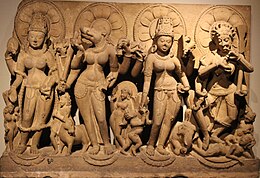
| Part of a series on |
| Shaktism |
|---|
 |
|
|
| Part of a series on |
| Hinduism |
|---|
 |
Shaktism (/ˈsæktɪzəm/; Sanskrit: शाक्तसम्प्रदायः, romanized: Śāktasampradāyaḥ) is a major Hindu denomination in which the godhead or metaphysical reality is considered metaphorically to be a woman.
Shaktism involves a galaxy of goddesses, all being regarded as different aspects, manifestations, or personifications of the divine feminine energy called Shakti. It includes various modes of worship, ranging from those focused on the most worshipped Durga, to gracious Parvati, and the fierce Kali. After the decline of Buddhism in India, various Hindu and Buddhist goddesses were combined to form the Mahavidya, a pantheon of ten goddesses. The most common forms of the Mahadevi worshipped in Shaktism include: Durga, Kali, Saraswati, Lakshmi, Parvati and Tripurasundari. Also worshipped are the various Gramadevatas across the Indian villages.
Shaktism also encompasses various tantric sub-traditions, including Vidyapitha and Kulamārga. Shaktism emphasizes that intense love of the deity is more important than simple obedience, thus showing an influence of the Vaishnavaite idea of passionate relationship between Radha and Krishna as an ideal bhava. Similarly, Shaktism influenced Vaishnavism and Shaivism. The goddess is considered the consort and energy (shakti) of the gods Vishnu and Shiva; they have their individual shaktis, Vaishnavi for Vishnu and Maheshvari for Shiva, and consorts Lakshmi and Sati/Parvati. An adherent of Shaktism is called Shakta. According to a 2010 estimate by Johnson and Grim, Shaktism is the third largest Hindu sect constituting about 3.2% of Hindus.
The Sruti and Smriti texts of Hinduism form an important scriptural framework in Shaktism. Scriptures such as the Devi Mahatmya, Devi-Bhagavata Purana, Kalika Purana, and Shakta Upanishads like the Devi Upanishad are revered. The Devi Mahatmya in particular, is considered in Shaktism to be as important as the Bhagavad Gita. The Devi is revered in many Hindu temples and is worshipped during various Hindu festivals. The goddess-focused tradition and festivals such as the Durga puja are very popular in the eastern India.